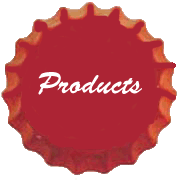
In 1886, when Atlanta and Fulton County passed prohibition legislation, Pemberton responded by developing Coca-Cola, essentially a non-alcoholic version of French Wine Cola. The first sales were at Jacob's Pharmacy in Atlanta, Georgia, on May 8, 1886. It was initially sold as a patent medicine for five cents a glass at soda fountains, which were popular in the United States at the time due to the belief that carbonated water was good for the health. Pemberton claimed Coca-Cola cured many diseases, including morphine addiction, dyspepsia, neurasthenia, headache, and impotence. Pemberton ran the first advertisement for the beverage on May 29 of the same year in the Atlanta Journal.
By 1888, three versions of Coca-Cola — sold by three separate businesses — were on the market. Asa Griggs Candler acquired a stake in Pemberton's company in 1887 and incorporated it as the Coca Cola Company in 1888. The same year, while suffering from an ongoing addiction to morphine, Pemberton sold the rights a second time to four more businessmen: J.C. Mayfield, A.O. Murphey, C.O. Mullahy and E.H. Bloodworth. Meanwhile, Pemberton's alcoholic son Charley Pemberton began selling his own version of the product.
John Pemberton declared that the name "Coca-Cola" belonged to Charley, but the other two manufacturers could continue to use the formula. So, in the summer of 1888, Candler sold his beverage under the names Yum Yum and Koke. After both failed to catch on, Candler set out to establish a legal claim to Coca-Cola in late 1888, in order to force his two competitors out of the business. Candler purchased exclusive rights to the formula from John Pemberton, Margaret Dozier and Woolfolk Walker. However, in 1914, Dozier came forward to claim her signature on the bill of sale had been forged, and subsequent analysis has indicated John Pemberton's signature was most likely a forgery as well.
In 1892 Candler incorporated a second company, The Coca-Cola Company (the current corporation), and in 1910 Candler had the earliest records of the company burned, further obscuring its legal origins. By the time of its 50th anniversary, the drink had reached the status of a national icon in the USA. In 1935, it was certified kosher by Rabbi Tobias Geffen, after the company made minor changes in the sourcing of some ingredients.
Coca-Cola was sold in bottles for the first time on March 12,
1894. The first outdoor wall advertisement was painted in the
same year as well in Cartersville, Georgia. Cans of Coke first
appeared in 1955. The first bottling of Coca-Cola occurred in
Vicksburg, Mississippi, at the Biedenharn Candy Company in
 1891.
Its proprietor was Joseph A. Biedenharn. The original bottles
were Biedenharn bottles, very different from the much later
hobble-skirt design that is now so familiar. Asa Candler was
tentative about bottling the drink, but two entrepreneurs from
Chattanooga, Tennessee, Benjamin F. Thomas and Joseph B.
Whitehead, proposed the idea and were so persuasive that Candler
signed a contract giving them control of the procedure for only
one dollar. Candler never collected his dollar, but in 1899
Chattanooga became the site of the first Coca-Cola bottling
company. The loosely termed contract proved to be problematic
for the company for decades to come. Legal matters were not
helped by the decision of the bottlers to subcontract to other
companies, effectively becoming parent bottlers. Coke
concentrate, or Coke syrup, was and is sold separately at
pharmacies in small quantities, as an over-the-counter remedy
for nausea or mildly upset stomach.
1891.
Its proprietor was Joseph A. Biedenharn. The original bottles
were Biedenharn bottles, very different from the much later
hobble-skirt design that is now so familiar. Asa Candler was
tentative about bottling the drink, but two entrepreneurs from
Chattanooga, Tennessee, Benjamin F. Thomas and Joseph B.
Whitehead, proposed the idea and were so persuasive that Candler
signed a contract giving them control of the procedure for only
one dollar. Candler never collected his dollar, but in 1899
Chattanooga became the site of the first Coca-Cola bottling
company. The loosely termed contract proved to be problematic
for the company for decades to come. Legal matters were not
helped by the decision of the bottlers to subcontract to other
companies, effectively becoming parent bottlers. Coke
concentrate, or Coke syrup, was and is sold separately at
pharmacies in small quantities, as an over-the-counter remedy
for nausea or mildly upset stomach.
On April 23, 1985, Coca-Cola, amid much publicity, attempted to change the formula of the drink with "New Coke". Follow-up taste tests revealed that most consumers preferred the taste of New Coke to both Coke and Pepsi, but Coca-Cola management was unprepared for the public's nostalgia for the old drink, leading to a backlash. The company gave in to protests and returned to a variation of the old formula, with high-fructose replacing cane sugar, under the name Coca-Cola Classic on July 10, 1985.
On February 7, 2005, the Coca-Cola Company announced that in the second quarter of 2005 they planned to launch a Diet Coke product sweetened with the artificial sweetener sucralose ("Splenda"), the same sweetener currently used in Pepsi One. On March 21, 2005, it announced another diet product, Coca-Cola Zero, sweetened partly with a blend of aspartame and acesulfame potassium. In 2007, Coca-Cola began to sell a new "healthy soda": Diet Coke with vitamins B6, B12, magnesium, niacin, and zinc, marketed as "Diet Coke Plus."
On July 5, 2005, it was revealed that Coca-Cola would resume operations in Iraq for the first time since the Arab League boycotted the company in 1968.
In April 2007, in Canada, the name "Coca-Cola Classic" was changed back to "Coca-Cola." The word "Classic" was truncated because "New Coke" was no longer in production, eliminating the need to differentiate between the two. The formula remained unchanged. In January 2009, Coca-Cola stopped printing the word "Classic" on the labels of 16-ounce bottles sold in parts of the southeastern United States. The change is part of a larger strategy to rejuvenate the product's image.










